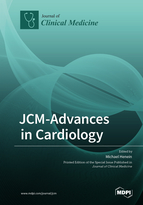JCM-Advances in Cardiology
A special issue of Journal of Clinical Medicine (ISSN 2077-0383). This special issue belongs to the section "Cardiology".
Deadline for manuscript submissions: closed (30 September 2021) | Viewed by 19064
Special Issue Editor
Interests: non-invasive cardiology including valve disease; coronary artery disease; heart failure; cardiovascular imaging
Special Issues, Collections and Topics in MDPI journals
Special Issue Information
Dear Colleagues,
Cardiology and cardiovascular sciences are two rapidly growing areas in medicine, with heart diseases being the number one cause of death worldwide. The last four decades have witnessed many developments in various cardiological sciences, including coronary artery disease, valve disease, heart failure, congenital heart diseases, and cardiovascular imaging, with a number of newly developed concepts, such as cardio-oncology, cardio-renal diseases, and preventive cardiology.
This Special Issue (SI) of the Journal of Clinical Medicine, entitled “JCM-Advances in Cardiology”, focuses on recent advances in the cardiological sciences. It aims to publish ground-breaking research articles of significant clinical and scientific value, including observational studies, clinical trials, and review articles. Unique clinical cases, particularly supported by advanced imaging, will also be welcome. We anticipate that the success of the Advances in Cardiology SI will result in the publication of other SI in different cardiology subspecialties.
Dr. Michael Henein
Guest Editor
Manuscript Submission Information
Manuscripts should be submitted online at www.mdpi.com by registering and logging in to this website. Once you are registered, click here to go to the submission form. Manuscripts can be submitted until the deadline. All submissions that pass pre-check are peer-reviewed. Accepted papers will be published continuously in the journal (as soon as accepted) and will be listed together on the special issue website. Research articles, review articles as well as short communications are invited. For planned papers, a title and short abstract (about 100 words) can be sent to the Editorial Office for announcement on this website.
Submitted manuscripts should not have been published previously, nor be under consideration for publication elsewhere (except conference proceedings papers). All manuscripts are thoroughly refereed through a single-blind peer-review process. A guide for authors and other relevant information for submission of manuscripts is available on the Instructions for Authors page. Journal of Clinical Medicine is an international peer-reviewed open access semimonthly journal published by MDPI.
Please visit the Instructions for Authors page before submitting a manuscript. The Article Processing Charge (APC) for publication in this open access journal is 2600 CHF (Swiss Francs). Submitted papers should be well formatted and use good English. Authors may use MDPI's English editing service prior to publication or during author revisions.
Keywords
- cardiology research
- cardiovascular disease
- heart valve disease
- coroanry artery disease
- myocardial disease
- heart failure
- preventive cardiology
- cardio-oncology
- cardio-renal diseases
- atherosclerosis
- arterial calcification







